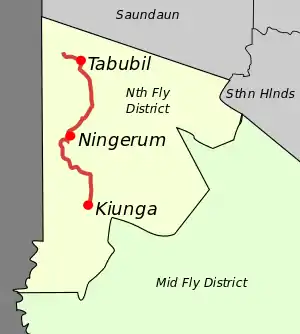Kiunga, Papua New Guinea
Kiunga is a port town on the Fly River[1] in the Western Province of Papua New Guinea,[2] just upstream from the D'Albertis Junction with the Ok Tedi River.[3] It is the southernmost terminus of the Kiunga-Tabubil Highway. Local industry rests on a cornerstone of freight and haulage, particularly from the Ok Tedi Mine and provisioning for the much larger town of Tabubil. Natural rubber has been an emerging industry more recently, with a processing/manufacturing plant being built in town.[4]
Kiunga | |
|---|---|
 Kiunga township from space | |
 Kiunga Location within Papua New Guinea | |
| Coordinates: 6°7′S 141°18′E | |
| Country | Papua New Guinea |
| Province | Western Province |
| District | North Fly |
| LLG | Kiunga Urban, Kiunga Rural |
| Elevation | 33 m (108 ft) |
| Population (2013) | |
| • Total | 18,747 |
| • Rank | 18th |
| Languages | |
| • Main languages | Tok Pisin, English |
| • Traditional language | Aekyom & Yongom |
| Time zone | UTC+10 (AEST) |
| Climate | Af |
Description
Surrounding swamps and rainforest lowlands are of interest to birdwatchers, with a high chance of observing crowned pigeon, yellow-eyed starling, large fig parrot and flame bowerbird as well as a large variety of more common species.
Kiunga has reliable 24-hour power. Locals are friendly, and there is no significant crime. Dial-up internet access is possible during business hours. Short term accommodation is available. Although Kiunga is accessible by road, this provides access only from Tabubil via the Kiunga-Tabubil Highway.
There are flights to and from the capital, Port Moresby, by both Airlines PNG and Air Niugini. Kiunga weather station readings are available online.[5] Its local geology is clay on limestone.
Population
According to data for 2013, the city's population was 18,747 people.[6] Historical data is listed below.
| 1980 | 1990 | 2000 | 2013 |
|---|---|---|---|
| 1,400 | 4,000 | 8,265 | 18,747 |
Climate
Kiunga has a tropical rainforest climate (Af) with very heavy rainfall year-round.
| Climate data for Kiunga | |||||||||||||
|---|---|---|---|---|---|---|---|---|---|---|---|---|---|
| Month | Jan | Feb | Mar | Apr | May | Jun | Jul | Aug | Sep | Oct | Nov | Dec | Year |
| Average high °C (°F) | 31.7 (89.1) |
31.6 (88.9) |
31.7 (89.1) |
31.4 (88.5) |
31.0 (87.8) |
30.1 (86.2) |
29.3 (84.7) |
29.9 (85.8) |
30.5 (86.9) |
31.5 (88.7) |
32.4 (90.3) |
32.0 (89.6) |
31.1 (88.0) |
| Daily mean °C (°F) | 27.2 (81.0) |
27.1 (80.8) |
27.2 (81.0) |
27.0 (80.6) |
26.9 (80.4) |
26.2 (79.2) |
25.6 (78.1) |
25.9 (78.6) |
26.2 (79.2) |
26.8 (80.2) |
27.5 (81.5) |
27.4 (81.3) |
26.7 (80.2) |
| Average low °C (°F) | 22.7 (72.9) |
22.6 (72.7) |
22.7 (72.9) |
22.7 (72.9) |
22.9 (73.2) |
22.4 (72.3) |
22.0 (71.6) |
21.9 (71.4) |
22.0 (71.6) |
22.1 (71.8) |
22.6 (72.7) |
22.9 (73.2) |
22.5 (72.4) |
| Average precipitation mm (inches) | 456 (18.0) |
403 (15.9) |
529 (20.8) |
399 (15.7) |
397 (15.6) |
317 (12.5) |
305 (12.0) |
317 (12.5) |
323 (12.7) |
339 (13.3) |
312 (12.3) |
424 (16.7) |
4,521 (178) |
| Source: Climate-Data.org[7] | |||||||||||||
See also
References
- Fly River chart folio : Korimoro Point to Kiunga navigation charts : hydrographic survey of the Fly River, Papua New Guinea - Western Province / prepared by Snowy Mountains Engineering Corporation Trove. National Library of Australia
- Lonely Planet
- KIUNGA Town Port along the FLY River in Western Province PNG, Photo by Malum Nalu, on 6-01-2013 geoview.info
- Rubber in Papua New Guinea
- Kiunga PNG National Weather Service.
- "Papua New Guinea Census of Population and Housing" (PDF). Archived from the original (PDF) on 2020-02-19. Retrieved 2018-09-13.
- "Climate: Kiunga". Climate-Data.org. Retrieved 19 October 2020.
